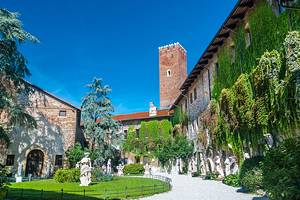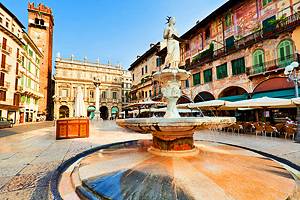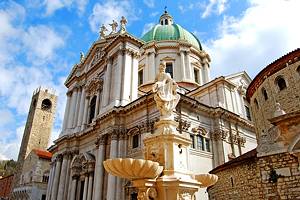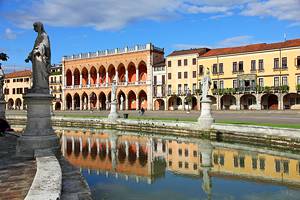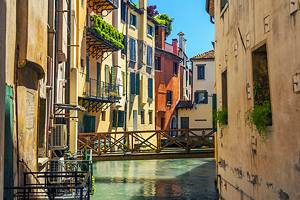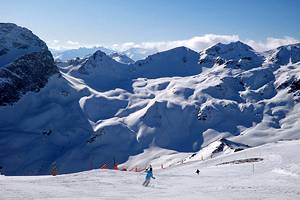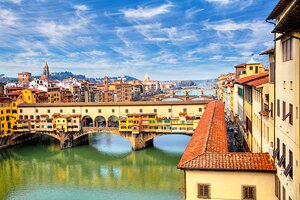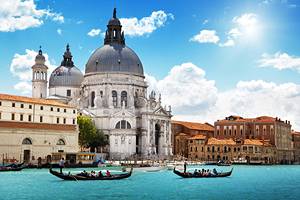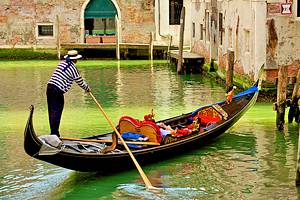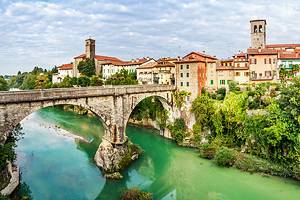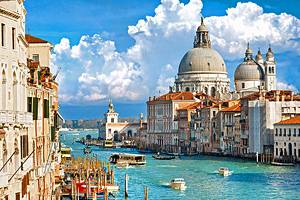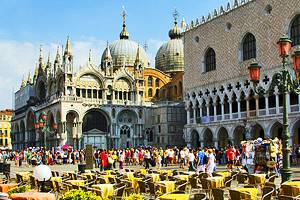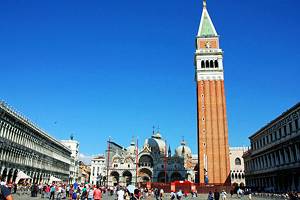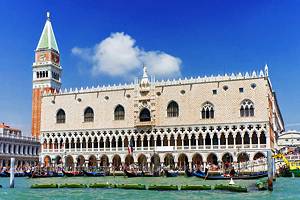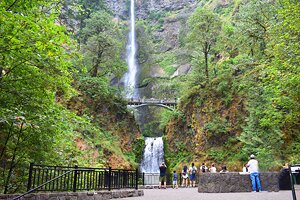14 Top-Rated Tourist Attractions & Things to Do in Trento
From its 13th-century castle to a collection of rare aircraft and the state-of-the-art MUSE science museum — a landmark of contemporary Italian architecture — Trento is full of surprises. Although its location at the junction of the trading route from Venice up the Val Sugana with the road over the Brenner Pass made it an important city since Roman times, its place in history was assured when the Council of Trent met and deliberated here from 1545 to 1563.
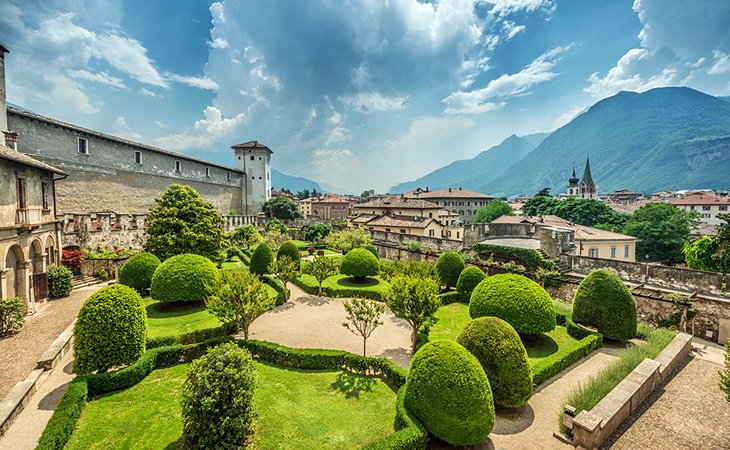
Prompted by the Protestant Reformation, the council laid down the rules and forms of the Counter-Reformation that shaped subsequent Roman Catholic doctrine into modern times. Between 1814 and 1918, Trento belonged to Austria, and after the peace treaty of Saint-Germain at the close of World War I, it became part of Italy, along with the rest of the Sudtirol region.
But unlike Bolzano and towns to the north, it has a distinctly Italian character. Along with seeing the tourist attractions, be sure to explore its streets and piazzas to admire the colorful frescoes that decorate the facades of many of Trento's buildings. Learn more about the best places to visit in and around this northern Italian city with our list of the top tourist attractions and things to do in Trento.
See also: Where to Stay in Trento
- 1. Castello del Buonconsiglio and Torre Aquila
- 2. MUSE (Museum of Science)
- 3. Piazza del Duomo and Neptune Fountain
- 4. Duomo (Cathedral)
- 5. Orrido di Ponte Alto
- 6. Museo Diocesano Tridentino (Diocesan Museum)
- 7. Museo dell'Aeronautica Gianni Caproni (Museum of Aeronautics)
- 8. Via Belenzani
- 9. Giardino Botanico Alpino Viote
- 10. Museo degli Usi e Costumi della Gente Trentina (Ethnographic Museum)
- 11. Day Trip to Lake Garda
- 12. Santa Maria Maggiore
- 13. Roman Tridentum
- 14. Visit Rovereto
- Where to Stay in Trento for Sightseeing
- Map of Tourist Attractions & Things to Do in Trento
1. Castello del Buonconsiglio and Torre Aquila
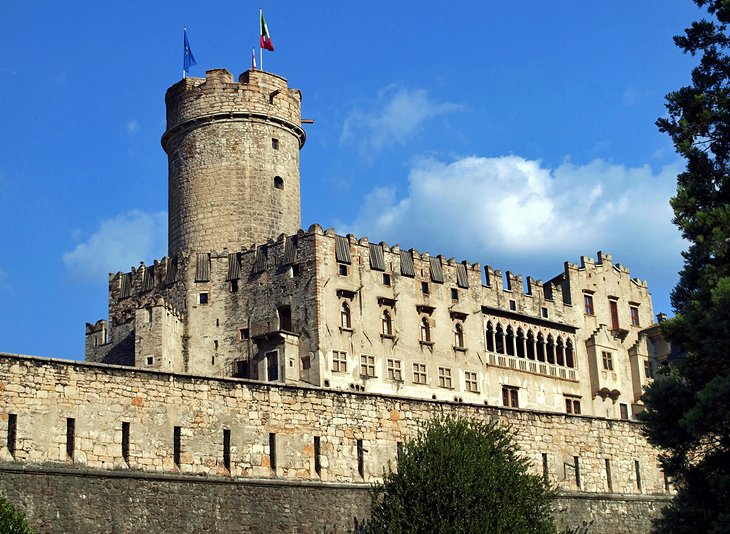
The largest castle complex in the region, Castello del Buonconsiglio was the residence of the prince-bishops of Trento from the 13th century to the end of the 18th century. A massive round tower dominates the 13th-century Castelvecchio, the oldest part, expanded with an Italian Renaissance-style Magno Palazzo in the 16th century and the Baroque Giunta Albertiana in the late 17th century.
At the south end is the Torre Aquila, whose interior is decorated with the exceptional 15th-century Cycle of the Months, one of the finest cycles of secular art from the late Middle Ages. It depicts court life and outdoor activities month by month.
Inside the Magno Palazzo, walls are decorated by another cycle of frescoes painted from the late Middle Ages to the Renaissance period. The Castello houses the Museo Provinciale d'Arte, with sculptures, period furniture, archaeological, and ethnological collections and the Museo del Risorgimento. These exhibits relate to Italy's struggle for unification and liberation from the Austro-Hungarian Empire.
Address: Via Bernardo Clesio 5, I-38100, Trento
2. MUSE (Museum of Science)
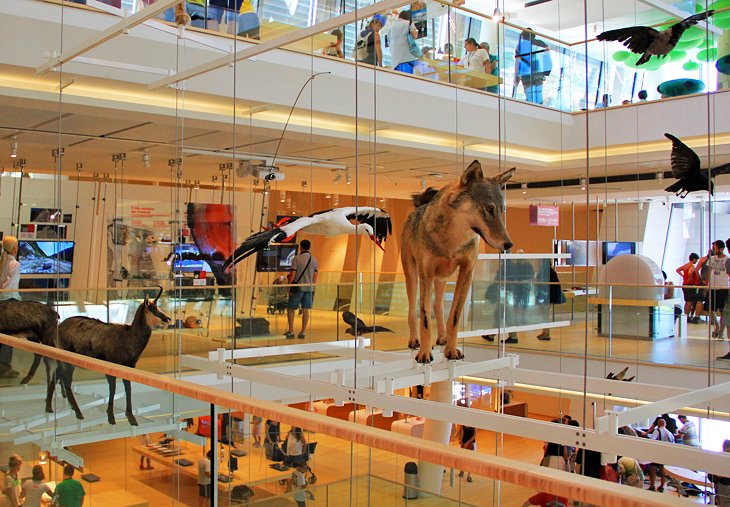
MUSE, the Museo delle Scienze di Trento (Museum of Sciences of Trento) opened in July, 2013 in a stunning building, a major showpiece of Italian architecture created by Renzo Piano Building Workshop. The LEED gold-rated building itself is worth seeing, the dramatic outline of its soaring glass walls echoing the silhouettes of the surrounding mountain peaks and slopes.
Inside, its various levels present the local mountain environment from the geologic formation and fossil record through prehistoric times and into the present natural environment of flora, fauna, landscapes, glaciers, and avalanches.
Throughout, it is filled with hands-on, multimedia, and sensory experiences that bring the artifacts and the subject to life. Although it is among the most popular places to go for families, this is not a museum just for children, but a dynamic introduction to the Alpine landscapes of northern Italy.
Address: Corso del Lavoro e della Scienza 3, Trento
Official site: www.muse.it
3. Piazza del Duomo and Neptune Fountain
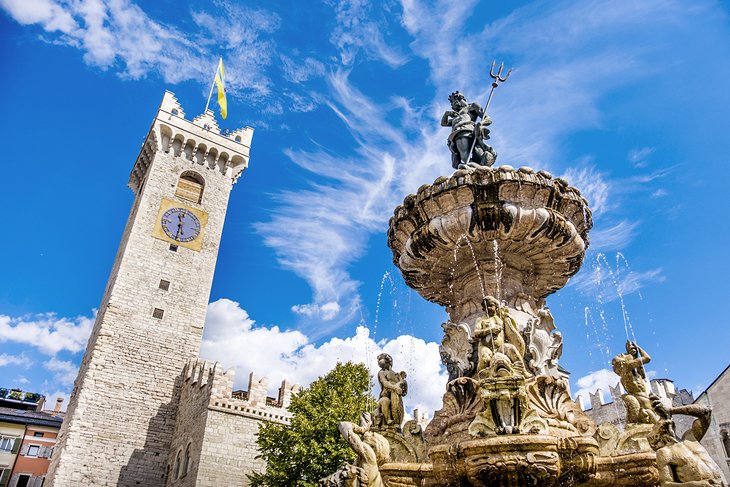
In the heart of Trento, Piazza del Duomo is the city's political, religious, and social center, as well as where you'll find many of its tourist attractions. At its center is the large Neptune Fountain, sculpted by Francesco Antonio Giongo in 1768.
Around the piazza are several places to visit, including the cathedral and Palazzo Pretorio, which houses the Diocesan Museum. The crenellated Vanga Tower overlooks the square from the ends of the palace. Opposite the Duomo, the arcades of Case Cazuffi-Rella support a richly painted façade.
4. Duomo (Cathedral)
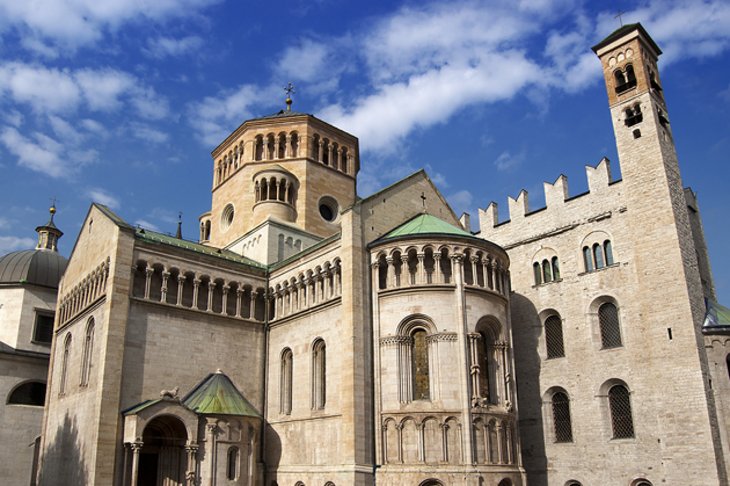
The cathedral, built in the 11th and 12th centuries, was remodeled inside at the beginning of the 13th century, and is remarkable for the combination of Lombard Romanesque style with the high vaulted ceiling more common to later Gothic architecture.
Also unusual are the two staircases built into the side walls leading up to the two bell towers. The interior has 13th- to 14th-century frescoes from Venetian, Lombardian, and late Gothic schools. Under the cathedral are the remains of an early Christian basilica (sixth century), with a fine mosaic floor.
The Council of Trent met in the church from 1545 to 1563, and in the south aisle, the Alberti chapel contains a large crucifix, in front of which the decrees of the Counter-Reformation were announced at its close.
Address: Piazza Duomo, Trento
5. Orrido di Ponte Alto
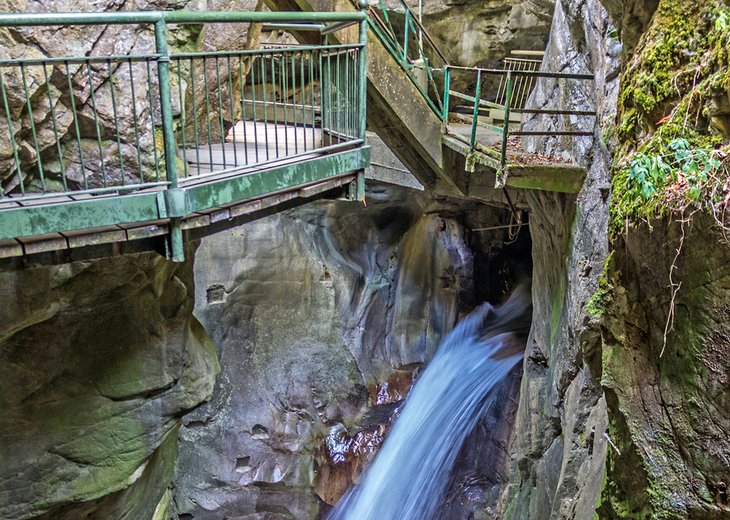
Near Trento, in the village of Cognola, two waterfalls plunge into a narrow canyon carved into the rock by the force of rushing water. Narrow walkways allow visitors to walk through the canyon to see the progression of rock walls sculpted into ever-more-fantastic shapes. The pair of spectacular waterfalls drop more than 40 meters between the rock cliffs.
It is not a good place for anyone with acrophobia, and you must go through with a guide, who explains the geology and history of the gorge (in the summer there are tours in English). The history is interesting: this is the site of some of Europe's most ancient hydraulic works, built in the early 1500s to protect the city from flooding.
Address: Via alla Cascata, Trento
6. Museo Diocesano Tridentino (Diocesan Museum)
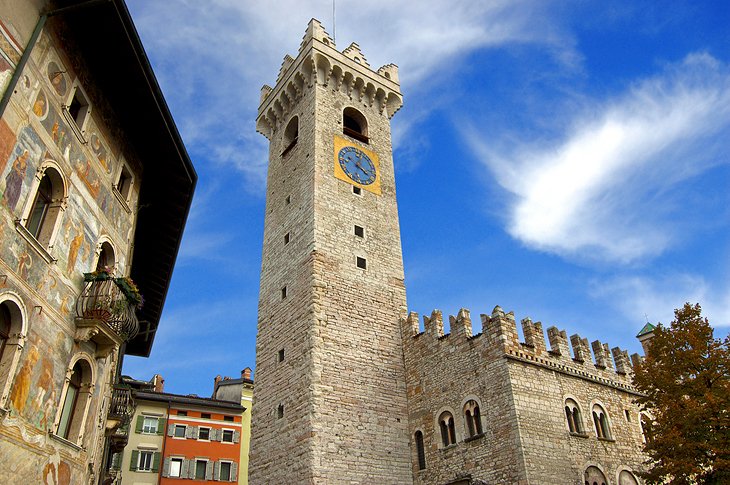
On the east side of the Piazza del Duomo is the Palazzo Pretorio, with the imposing Torre Grande (clock tower). Inside the palace is the Diocesan Museum, whose collections, although religious in nature, document the development of local artistic styles and techniques from the 11th through the 19th century, especially in wood carving and sculpture.
The rich treasury includes fine silver and gold work, early embroidered liturgical vestments, rare illuminated manuscripts, paintings, and 16th-century Flemish tapestries. A multimedia station illustrates the successive stages of building the cathedral.
Address: Piazza Duomo 18, Trento
Official site: www.museodiocesanotridentino.it
7. Museo dell'Aeronautica Gianni Caproni (Museum of Aeronautics)
Italy's oldest aviation museum lies next to the Trento Airport, dedicated to the memory of Gianni Caproni, the Italian aeronautical engineer and aircraft designer. More than two dozen aircraft are exhibited in the museum, including a number of Caproni planes, a Lockheed F-104G Starfighter, and the only surviving fuselage of a Fokker D.VIII.
Eight other aircrafts on display are the only surviving examples in the world. Many of these are prototypes built by Caproni, including the Caproni Vizzola C-22J, designed in 1980 for the US Air Force as a training craft. The Lockheed F-104 Starfighter is a 1950s prototype of fighter planes used until 2000.
Address: Via Lidorno 3, Trento
Official site: http://www.museocaproni.it/index.php/en/
8. Via Belenzani
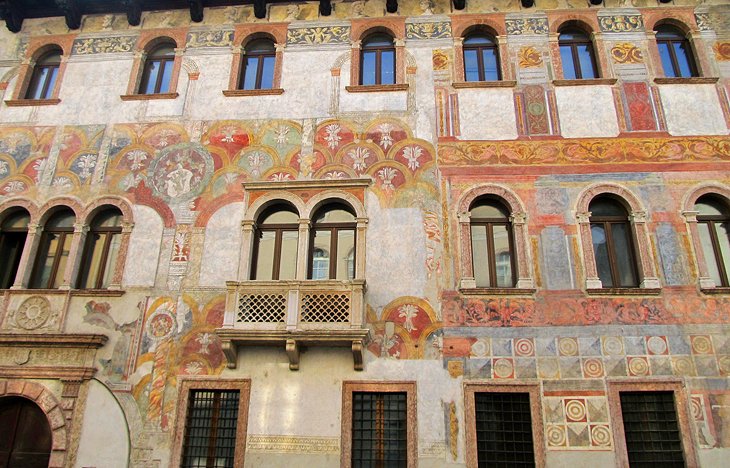
The wide street, Via Belenzani, runs north from the Piazza del Duomo, and you should follow it, looking upward to see some of the best of Trento's painted facades. This is the finest street in town, with a series of palaces painted with historical, classical, and mythological motifs and faux architectural details.
Near the north end of the street, on the right, is the 16th-century Palazzo Municipale, with the 15th-century Casa Geremia opposite. Built by the son of a Veronese nobleman, Casa Geremia is known particularly for the restored frescoes on the façade. You'll also find a chocolate shop, bookstore, and gelateria on Via Belenzani and more on the nearby streets; this is a good neighborhood for shopping in Trento.
Address: Via Belenzani, Trento
9. Giardino Botanico Alpino Viote
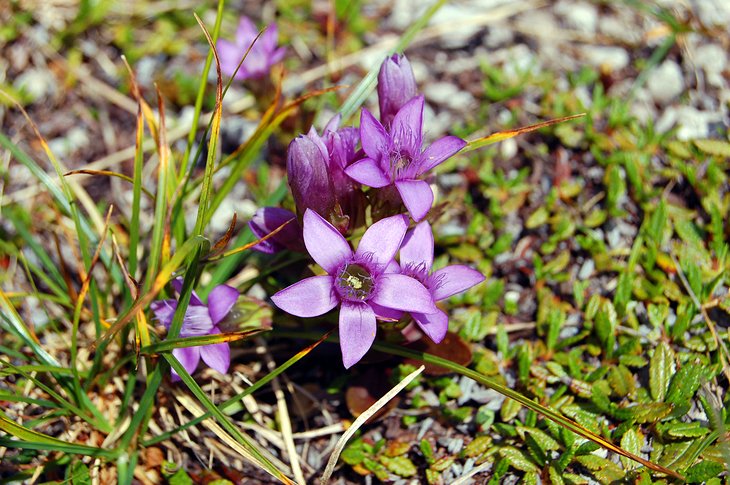
No matter what route you take to get to Viote, it's a 40- to 50-minute drive on curving mountain roads. But for those interested in the Alpine regions of the world and in their plants and geology - or who enjoy exploring the ragged landscapes of the Adige valley, this garden is worth the trip into the mountains.
One of the oldest and largest in the Alps, the garden protects a collection of about 2,000 species of high altitude plants from all over the world, many of them rare and endangered. An unusual addition for a botanic garden is the Geological Garden, which shows the many unusual rocks from the various valleys of the Trentino province.
Address: Località Viote, Trento
10. Museo degli Usi e Costumi della Gente Trentina (Ethnographic Museum)
One of Italy's best and largest museums of culture and popular traditions, and one of the best anywhere in the Alpine region is just outside of Trento, in the Adige Valley. The Trentina Ethnographic Museum fills 41 exhibit rooms on four floors.
Its specialty is the agricultural traditions and methods of the Alps, and it includes tools and implements for haymaking, timber cutting, cheesemaking, beekeeping, and a complete water mill for grinding grains. Other sections cover artisans such as woodcarvers, wood-turners, cartwrights, wheelwrights, and metal workers forging copper and iron.
A textile section includes wool preparation, spinning, and weaving, and the museum also displays a large collection of kitchen implements, pottery, copper vessels, and bronze pans from the 16th and 17th centuries. Folk costumes, folklore, carnival masks, musical instruments, religious customs, nuptial traditions, hunting, and wine making round out the exhibits.
Address: Via Mach 2, San Michele All'Adige
Official site: http://www.museosanmichele.it/?lang=en
11. Day Trip to Lake Garda
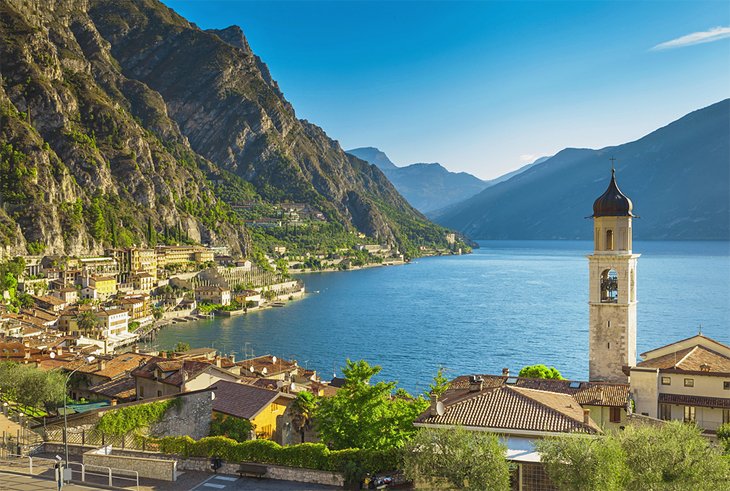
Route SS45 leads through a verdant valley and the beautiful town of Arco to Riva del Garda, 40 kilometers from Trento. Riva sits at the head of Lake Garda, a tourism magnet known for its magnificent scenery and for water sports - Torbole, just east of Riva is the windsurfing capital of Italy.
Roads hug the shore for almost the entire perimeter of the lake, which is 52 kilometers in length. You could drive around the entire lake in a day, but a better day trip from Trento is to drive down the eastern shore, where the most interesting villages are, with times for stops to explore Malcesine's narrow streets and linger in other lakeside towns. Or you could take a lake steamer from Riva to visit Malcesine and its castle, from which you'll see some of the most beautiful views of Lake Garda and its dramatic western shore.
12. Santa Maria Maggiore
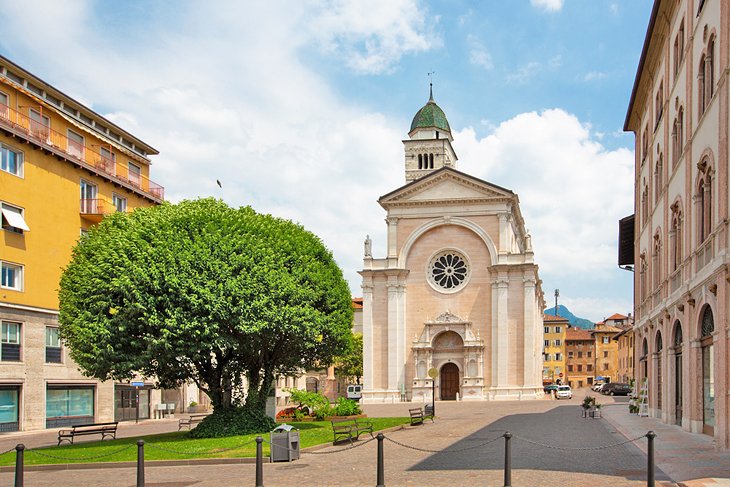
Renaissance church of Santa Maria Maggiore (1520-23), northwest of the cathedral, is built of red marble and white limestone. In the choir are a beautiful organ gallery from 1534 and a fresco from 1563 showing likenesses of the members of the Third Session of the Council of Trent, which met here.
One of the side chapels has an especially beautiful Baroque altar. The church's campanile, bell tower, is the city's tallest, at 53 meters. The column beside the church commemorating the 300th anniversary of the Council of Trent was placed there in 1845.
Address: Piazza Santa Maria Maggiore, Trento
13. Roman Tridentum
Under Trento lie remains of the buried Roman city of Tridentum, about 1,700 square meters of excavations, which reveal part of the city wall, a long stretch of stone-paved street, sections of houses with mosaics, courtyards, a well, and workshops. It's not a very large site, but it is well interpreted to give a picture of Roman Trento.
Because this Roman city was built upon for two millennia, the excavations represent successive eras, with remains from the Middle Ages and the Renaissance. If you are not visiting the Roman sites farther south in Italy, this is a good place to go with children, so they can glimpse life in the time of ancient Rome.
Address: Piazza Cesare Battisti, Trento
14. Visit Rovereto
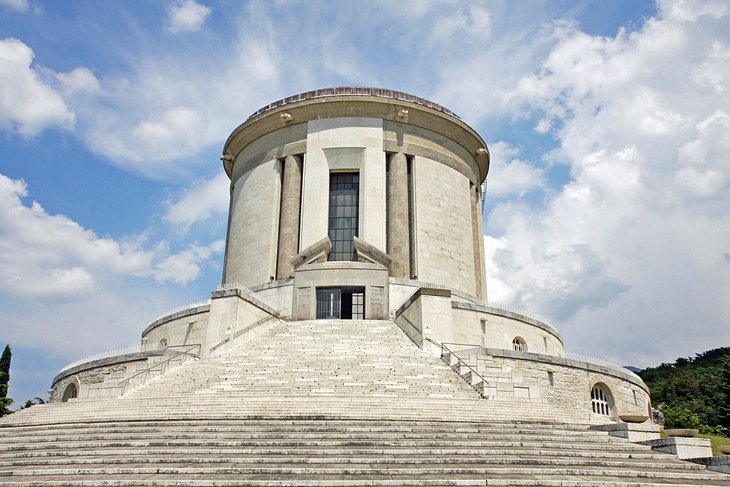
South of Trento is Rovereto, crowned by the 14th-century Castello with beautiful views of the town below and the mountains rising from the Adige Valley. Inside is one of the region's best museums of the two world wars — especially the first, which was fiercely fought in this valley — and their effect on local towns. The artifacts are so well curated and displayed, and so complete, that you don't need to read Italian to get a clear picture of the times.
Near the center of town, the Museo Civico explores local silk manufacturing and has worthwhile collections of Greek and Roman artifacts, as well as local dinosaur finds. Ask here for directions to dinosaur tracks on the hillside above town. On the way here, you'll pass a circular building, the Sacrario di Castel Dante, containing the remains of more than 20,000 dead of the First World War. Above it is a gigantic bell cast in 1965 to commemorate the dead of all nations, which is rung each evening.
Where to Stay in Trento for Sightseeing
With all the things to see in the historic center, we recommend these well-located hotels in Trento, close to the old town and other other top places to go:
- The old-world feel of the Grand Hotel Trento is enhanced by crystal chandeliers, etched glass windows, and coffered ceilings. Guest rooms are well decorated, and many are large enough to accommodate families. Despite its central location there is parking for guests.
- The mid-range Hotel America is steps from the old town, with spacious rooms and great buffet breakfasts.
- Also with a central location, Hotel Buonconsiglio has modern décor; rooms have refrigerators, safes, and hair dryers.
- B&B La Malvasia offers comfortable rooms, some with extra beds for families, within an easy walk of the central attractions. Breakfast is included.
Map of Tourist Attractions & Things to Do in Trento
More Related Articles on PlanetWare.com
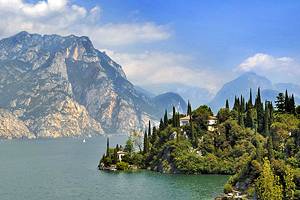
Places to Visit near Trento: Trento is well-located for exploring the Alto Adige region and the tourism highlights around it. If the underground excavations here make you want to see more Roman sites, head south to see the well-preserved Roman arena and other historic sights of Verona. On the way, you may want to take some time to drive along the shores of Lake Garda.
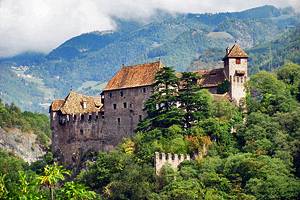
Places to Visit North of Trento: Perhaps after visiting Italy you are stopping in Trento on your way north into the Austrian Tirol. You'll feel as though you're already here when you see the charming blend of Italian and Germanic cultures in Bolzano and Italy's Südtirol. Beyond, in the heart of the Austrian Tyrol, is the former Hapsburg imperial city of Innsbruck; you'll find suggestions of places to visit here in our article on the Top Tourist Attractions in Innsbruck & Easy Day Trips.




